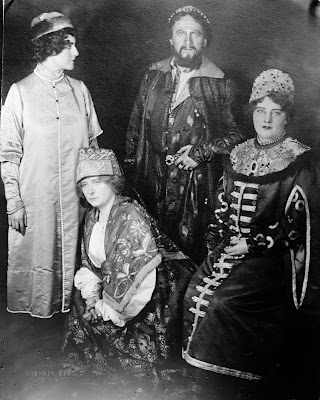Anna Case often stated that she was never given her "big break" by anyone - that she earned all of her success through her own hard work and determination. There is no better example of that than her performance as Fyodor in the American debut of Modest Mussourgsky's "Boris Godunov".
 |
| Anna Case, Maria Duchene, Adamo Didur, Leonora Sparkes |
When she stepped onto the stage of the Metropolitan Opera House on March 19, 1913, she brought with her more than just her exquisite soprano voice - namely, ninety-seven superb performances in eleven different supporting roles over a grueling three-and-a-half years.
 |
| Boris Godunov Coronation Scene |
For years she had been requesting the roles that went with the arias she was singing to rave reviews at the Met's Sunday Night Concert series and in her own concert tours. She was told repeatedly that she did not have an "above-the-title" name that would sell tickets. As she recounted for an Opera News reporter in 1970, her reply was, "put me on with Caruso, and I will draw".
 |
| Anna Case with Enrico Caruso, May 1917 |
Indeed, she did share the stage with Enrico Caruso in a few lesser roles, but it wasn't until she threatened to quit the company - a bold move that shocked the Met's directors ("No one quits the Metropolitan Opera!") - that she was cast as Boris's son Fyodor in Mussourgsky's unique opera.
 |
| Anna Case, Adamo Didur |
Almost forty years old by the time of its American debut, Boris Godunov is interesting not only because of its long compositional history - it was extensively reworked by Rimsky-Korsakov after Mussourgsky's death - but also for its use of scenery and costumes. Sets were not "built out" in the traditional manner, but instead consisted entirely of enormous canvas backdrops, one for each of the opera's eight scenes, painted in a modern, almost cubist, style. Costumes were not designed but were authentic antique Russian wardrobe of the depicted era.
 |
| Anna Case as Fyodor in Boris Godunov, her first starring role. |
Anna Case continued in the role of Fyodor until the conclusion of the 1912-1913 season in April. She would not again grace the Metropolitan stage until December when she would sing what would become her signature role, Sophie, in the American debut of Strauss's Der Rosenkavalier. Although, from the photo below which appeared in a 1919 issue of Theatre magazine, it seems she held a special place in her heart for the role in which she created her big break!

No comments:
Post a Comment